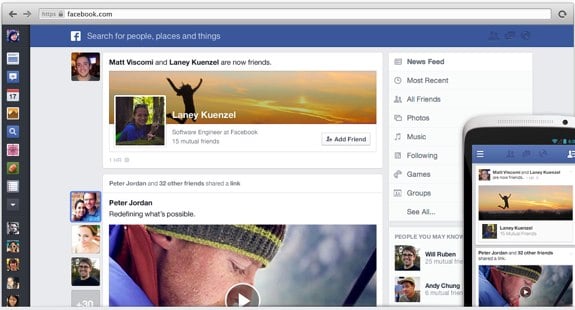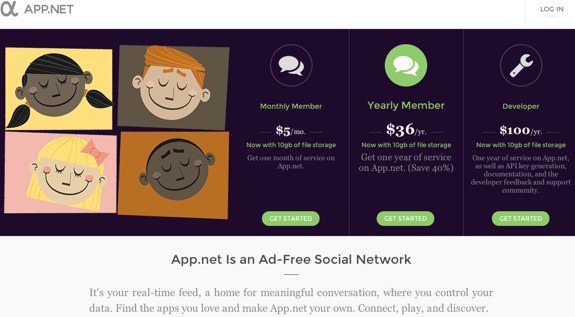Latest Gear Live Videos
Tumblr user numbers in massive freefall

Posted by Ariel Levin-Waldman Categories: News, Social Media, Social Networks,

Over a year ago, Yahoo purchased the blog host Tumblr for $1.1 billion. Today their investment is not looking so good. Rather than seeing growth, in the past six months Tumblr had lost over 7 million users.
Back in December, Tumblr boasted 49 million regular users. As of yesterday, consumer reports showed only 42 million. That's a 15 percent drop in traffic, presenting a problem for Yahoo, which has been trying to attract advertisers for the blogging service in order to monetize it.
When Yahoo first made the purchase, they stated that they would not make changes, and true to their word, Tumblr has remained more or less the same as it has been for years. No overhead policy change can really explain the loss of users (and consequently revenue.)
Click to continue reading Tumblr user numbers in massive freefall
Advertisement
Twitter finally allows you to mute your friends

Posted by Ariel Levin-Waldman Categories: Corporate News, Social Media, Social Networks,

It's pretty hard to get a message across in 140 characters or less. I know, I'm a journalist and I've had to do it professionally. But maybe you feel you are still getting too much information that you might not want. Maybe you just have a friend who has tweeted you to save the whales twenty times too many.
Well, now you can mute them.
Twitter has just unveiled its newest feature, the mute option. With the press of a button the you can select users in your feed that you just don't want to hear any more. You will no longer see their tweets, retweets, SMS or push notifications
It's not a full block feature. The biggest difference is that they can still follow you. They can still see your feed, share and retweet your posts and reply to you. You just won't see it in your timeline. They can also send you a direct tweet. The muted user does not receive any notification that you have shut them up.
You won't have to listen to them and they won't be upset with you. Now I can get back to seeing what trending without having to save any of those darned whales.
The Problem with Facebook [Video]

Posted by Andru Edwards Categories: Revenue, Social Media, Social Networks,
The problem is the only way Facebook has found to make money is by treating all entities on the site as advertisers and charging them to share their content.
This business plan backfires because 1) not all entities ARE advertisers and 2) it was the content from these people, specifically friends, family, and creators that made the site worth visiting in the first place.
Now the incentives are misaligned:
- Individuals want to see great content, but they are now seeing more paid content and organically shared content which appeals to the lowest common denominator (babies, weddings, and banal memes)
- Creators want to reach fans but their posts are being throttled to force them to pay to be seen
- Brands and advertisers have to pay once to advertise their page on Facebook, and then pay again to reach the people who have already liked their page. Plus Facebook is not a place where people generally go to buy things.
Facebook stands in contrast to other social media like Twitter, YouTube, and Instagram where all content is shared with all followers.
Facebook’s new News Feed focuses on multimedia [Video]

Posted by Andru Edwards Categories: Corporate News, Design, Social Media, Social Networks,

Facebook has announced a greatly revamped News Feed that hopes to beautify all the content that you consume on the social network. The new News Feed separates the different categories of content, making it easier to get to, say, just photo updates, or music updates, or groups, for example. Mark Zuckerberg says the new design is akin to a "personalized newspaper." The thought behind the changes are that people are sharing more and more multimedia--images, videos, links with previews…so why not take advantage of the screen space and optimize it?
Click to continue reading Facebook’s new News Feed focuses on multimedia [Video]
App.net introduces free accounts with an invitation system

Posted by Andru Edwards Categories: Revenue, Social Media, Social Networks, Startups,

App.net has decided to remove the cost of entry for some users, as it now allows those with paid accounts to invite up to three people to the service for free. If you're unfamiliar with App.net, it's a Twitter-like service that is free of advertising, instead allowing members to pay a $36 annual fee to be a part of it. Members own the data they put into it and don't need to give up any rights, and that includes the 10 GB cloud storage that tied to the App.net File API. Free users will have some limitation, though. For one, you'll only be able to follow a maximum of 40 other users, and instead of the aforementioned 10 GB of cloud storage, you get 500 MB instead. Lastly, paid accounts are allowed to upload files up to 100 MB in size, while free accounts have a 10 MB size restriction.
If you want to get in on App.net and don't feel like paying, hit up your paid user brethren and beg for an invite.
Read More  | App.net
| App.net
Twitter t.co shortener adds two more characters, shortens tweets

Posted by John Kilhefner Categories: News, Social Networks,
.jpg)
If you thought that 140 characters was just not enough to thoroughly get your point across on Twitter, get ready, because any URLs you add to your tweet out are going to make them even shorter.
Starting today, including a URL in your tweet will leave you with 118 characters, or 117 for https links. This tweet reduction was announced in December due to a change in Twitter's t.co link wrapper, which extends the maximum length of links from the previous 20 characters to 22, and 21 to 23 for https.
What does this mean for you? You'll have two less characters to annoy people with your updates.
Read More  | Twitter
| Twitter
Facebook to reveal ads targeted to user behavior patterns

Posted by John Kilhefner Categories: Advertising, Corporate News, Social Media, Social Networks,

Facebook is now compliant with the Online Interest-Based Advertising Accountability Program, and has to show the AdChoice icon in behaviorally targeted Facebook Exchange (FBX) ads. This allows users to know when an ad is marketed to them on their browser behavior. The catch, however, is that the icon is only displayed when a user interacts with it by scrolling of the gray "X" over the ad.
Facebook will change the "Report this Ad" text with "Learn About Facebook Ads," and users can choose to opt out of specific ad networks. As Engadget notes, however, whether this legally complies with the Federal Commission guidelines for "clear and prominent notice" is unsure, as the ads only reveal itself as targeted once a user interacts with it.
AdChoice implementation will start at the end of March.
Read More  | ASRC Reviews via AdAge
| ASRC Reviews via AdAge
Twitter acquires Bluefin Labs to create innovative ad products

Posted by John Kilhefner Categories: Acquisitions, Advertising, Social Networks,

Twitter is expanding on its Nielsen deal to develop social TV ratings through an acquisition of Bluefin Labs, a firm specializing in statistics for television networks. The acquisition, says Twitter, will allow the social network to create "innovative new ad products."
Second-screen apps seem to be on the rise these days, but in the case of Twitter, people are more than likely already using it while watching TV. The question is, how much money will this bring Twitter through advertising?
Read More  | Twitter Blog via Engadget
| Twitter Blog via Engadget
Instagram co-founder Kevin Systrom responds to backlash

Posted by John Kilhefner Categories: Legal, News, Social Networks,
.jpg)
Instagram wants you to know that it hears your concerns and its doing its best to alleviate the symptoms of change. Accordingly, the photo-sharing service has altered the parts of its new Terms of Service.
Earlier, we reported that many people were leaving the service for Flickr and the like, because people took the new ToS to mean the community's photos would be unfairly monetized for Instagram's gain. Kevin Systrom, co-founder of Instagram, has since made it clear that is not the case. Systrom states that Instagram wants "to experiment with innovative advertising." Which according to Systrom means allowing Instagram access to people you follow, and who they follow, for businesses to use in order to better promote its business.
Systrom also claimed that users still own their content and that his company won't sell user photos to advertisers.
Read More  | Instagram Blog
| Instagram Blog
New algorithm attempts to debunk false information on Twitter

Posted by John Kilhefner Categories: News, Social Networks, Startups,
 While Twitter has been described as a "self-cleaning oven" and a "truth machine," rumors do slip through and cause confusion, if briefly. A new study building on research done in 2010, analyzing tweets surrounding the Chile 8.8 earthquake, is currently researching the possibilities of sussing out the true tweets from the false ones.
While Twitter has been described as a "self-cleaning oven" and a "truth machine," rumors do slip through and cause confusion, if briefly. A new study building on research done in 2010, analyzing tweets surrounding the Chile 8.8 earthquake, is currently researching the possibilities of sussing out the true tweets from the false ones.
The study uses 16 features to identify whether a tweet is credible or not. It seems reliable information tends to be longer and include URLs, as well as come from people with a lot of followers. The true tweets also tend to be negative in nature, and do not contain exclamation points or question marks.
A new paper by those behind the Chile earthquake study, Carlos Castillo, Marcelo Mendoza and Barbara Poblete, will appear in the journal Internet Research next month with what look to be encouraging results. Their algorithm had an AUC of 0.86, meaning that when it's presented with a false tweet and a true tweet, it would label the true tweet more credible 86 percent of the time.
It's not perfect, and actual people would probably fair better in determining which tweet was more credible. Probably. In any case, it's nice to see we're making strides toward making the Internet a more credible place. My only concern is the escalation factor; that is, the people behind the deliberately false information will only adopt better practices to fool such truth-seeking algorithms.
Read More  | Slate
| Slate
Advertisement
© Gear Live Media, LLC. 2007 – User-posted content, unless source is quoted, is licensed under a Creative Commons Public Domain License. Gear Live graphics, logos, designs, page headers, button icons, videos, articles, blogs, forums, scripts and other service names are the trademarks of Gear Live Inc.










